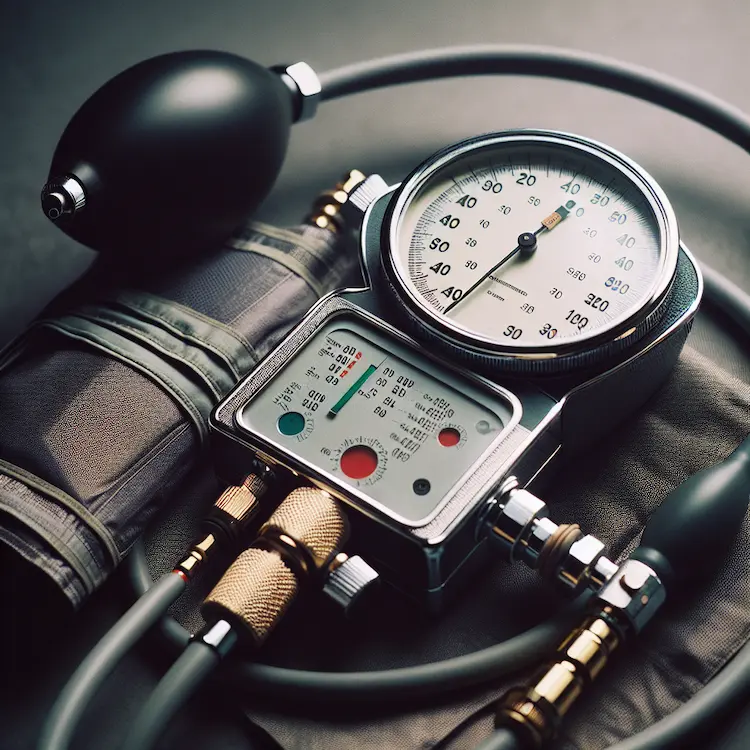A sphygmomanometer, also known as a blood pressure monitor or blood pressure gauge, is a medical device used to measure blood pressure. This essential instrument plays a crucial role in diagnosing and monitoring hypertension, a condition that affects millions of people worldwide. Understanding the sphygmomanometer’s definition, purpose, and basic components is vital for healthcare professionals and patients alike.
Definition and Etymology
The term “sphygmomanometer” derives from the Greek words “sphygmos,” meaning pulse or heartbeat, and “manometer,” referring to a device that measures pressure. This etymology accurately describes the instrument’s function: measuring the pressure of blood as it flows through the arteries.
Purpose and Importance
The primary purpose of a sphygmomanometer is to measure blood pressure, which is the force exerted by circulating blood on the walls of blood vessels. This measurement is crucial for several reasons:
- Diagnosing hypertension
- Monitoring cardiovascular health
- Assessing the effectiveness of blood pressure medications
- Screening for potential health issues
Accurate blood pressure measurements are essential for proper diagnosis and treatment of various cardiovascular conditions. Regular monitoring can help prevent complications associated with high blood pressure, such as heart disease, stroke, and kidney problems.

Basic Components of a Sphygmomanometer
A typical sphygmomanometer consists of several key components:
- Inflatable Cuff: A fabric cuff that wraps around the upper arm and contains an inflatable bladder.
- Inflation Bulb: A rubber bulb used to manually inflate the cuff.
- Air Release Valve: Allows controlled deflation of the cuff.
- Measuring Unit: Typically a mercury column, aneroid gauge, or digital display.
- Tubing: Connects the cuff to the measuring unit.
- Stethoscope (for manual devices): Used to listen for Korotkoff sounds during measurement.
Types of Sphygmomanometers
There are three main types of sphygmomanometers:
- Mercury Sphygmomanometer: Considered the gold standard for accuracy, but less common due to environmental concerns about mercury.
- Aneroid Sphygmomanometer: Uses a mechanical system with a dial gauge to display pressure readings.
- Digital Sphygmomanometer: Employs electronic sensors and a digital display for automated readings.
Comparison of Sphygmomanometer Types
| Type | Accuracy | Ease of Use | Portability | Environmental Impact |
|---|---|---|---|---|
| Mercury | High | Moderate | Low | High |
| Aneroid | Moderate | Moderate | High | Low |
| Digital | Moderate to High | High | High | Low |
How a Sphygmomanometer Works
The working principle of a sphygmomanometer is based on occluding the artery and then gradually releasing the pressure to measure systolic and diastolic blood pressure. Here’s a step-by-step explanation:
- The cuff is wrapped around the upper arm and inflated until it completely stops blood flow in the brachial artery.
- As the cuff is slowly deflated, the first sound of blood rushing back through the artery (Korotkoff sound) indicates the systolic pressure.
- The point at which these sounds disappear marks the diastolic pressure.
- The readings are typically expressed as systolic over diastolic pressure, e.g., 120/80 mmHg.
Digital sphygmomanometers use oscillometric techniques to determine blood pressure, detecting subtle changes in pressure as blood flows through the artery.

Accuracy and Proper Use
To ensure accurate readings, it’s crucial to use the sphygmomanometer correctly:
- Choose the right cuff size for the patient’s arm circumference.
- Position the patient correctly, with the arm at heart level.
- Take multiple readings and average the results.
- Calibrate the device regularly, especially for aneroid models.
Healthcare professionals should be trained in proper technique to avoid common errors that can lead to inaccurate measurements.
Importance in Healthcare
Sphygmomanometers play a vital role in various healthcare settings:
- Clinical Practice: Regular blood pressure checks during routine visits.
- Emergency Medicine: Rapid assessment of patient’s cardiovascular status.
- Home Monitoring: Allows patients to track their blood pressure between doctor visits.
- Research: Essential for studying cardiovascular health trends and treatment efficacy.
Studies have shown that home blood pressure monitoring can lead to better blood pressure control. One study found that patients who used home sphygmomanometers had an average decrease of 3.7 mmHg in systolic and 2.8 mmHg in diastolic blood pressure.
Technological Advancements
Recent innovations in sphygmomanometer technology include:
- Wearable Devices: Continuous blood pressure monitoring through smartwatches and other wearables.
- Smartphone Integration: Apps that sync with Bluetooth-enabled sphygmomanometers for easy tracking and sharing of data.
- Cuffless Technology: Emerging methods that measure blood pressure without the need for a traditional cuff.
These advancements aim to make blood pressure monitoring more convenient and accessible, potentially improving overall cardiovascular health management.
Conclusion
The sphygmomanometer remains an indispensable tool in modern healthcare. Its ability to accurately measure blood pressure provides crucial information for diagnosing and managing cardiovascular conditions. As technology advances, we can expect even more precise and user-friendly devices to emerge, further enhancing our ability to monitor and maintain cardiovascular health.
Understanding the basics of sphygmomanometers empowers both healthcare providers and patients to take an active role in managing blood pressure. Regular monitoring, combined with lifestyle modifications and appropriate medical interventions, can significantly reduce the risk of cardiovascular complications and improve overall health outcomes.


